| Spring types | ||
| Overview of the different types of spring used in mechanical seals | ||
| Only compression springs are used in mechanical
seals. As a secondary function, springs (conical springs) can perform the job of torque transmission in mechanical seals. Mechanical seals of this type are, however, dependent on the direction of rotation (direction of rotation). |
Metal bellows | Wave springs |
| Wave springs (single springs) | ||
|
|
|
| Rolled bellows version | 2-disk version | |
 No weld or just one weld, with lower flexibility and a greater radial and axial mounting height than laminated bellows. |
|
|
| Laminated bellows (diaphragm bellows) version | X-Version |
|
 Disks welded at outside and inside diameter, with greater flexibility than rolled bellows. Much shorter overall length and smaller radial height. |
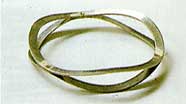 Multi-wave version |
|
| Mounting examples of mech. seals with metal bellows spring backing | Mounting examples of mechanical seals with wave springs | |
 Rolled bellows mechanical seal independent of direction of rotation |
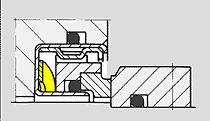 Stationary mechanical seal independent of direction of rotation, with one single-disk wave spring. Extremely short overall length. |
|
 Short-length laminated mechanical seal independent of direct. of rotation |
 Mechanical seal independent of direction of rotation, with a 2-disk wave spring. |
|
Characteristics |
Characteristics | |
|
|
|
| Helical springs | ||
| Conical spring (single spring) | Cylindrical compression springs (single or multiple springs) | |
 Right-
or left-handed Right-
or left-handed |
 Right-
or left-handed (single spring) Right-
or left-handed (single spring) |
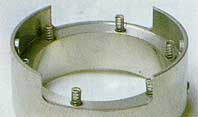 Spring backing with several small cylindrical compression springs (multiple spring) |
Versions |
Versions |
|
 Spring end with axial klink. Lug turned 90° axially.
Spring end with axial klink. Lug turned 90° axially. |
 Spring
end with axial klink. Lug turned 90° axially. Spring
end with axial klink. Lug turned 90° axially. |
Multiple spring with diameter, wire thickness and length in a
healthy relationship. Buckling strength is guaranteed. No need to guide spring. Unsuitable
for large axial displacements. 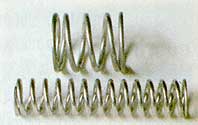 Extremely slender multiple spring. Without a guide, buckling strength is no longer assured. The long useful spring excursion allows for large axial displacements. |
Mounting examples of mechanical seals |
||
 Spring end with radial kink in the mechanical seal, self-locking to shaft. Mechanical seal is dependent of the direction of rotation. Observe the shaft's direction of rotation and the spring's sense of coiling. |
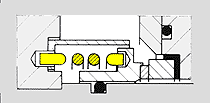 Both spring ends with axial kink for torque transmission. Suitable for brief changes in the direction of rotation. Observe the shaft's main direction of rotation and the spring's sense of coiling. |
|
 Spring end with axial kink in mechanical seal radial to shaft. Brief changes in direction of rotation are possible, but mechanical seal is dependent nevertheless on the direction of rotation. Observe the shaft's main direction of rotation and the spring's sense of coiling. |
 Both spring ends with radial kink to the outside for torque transmission. |
Mounting examples of mechanical seals
Mechanical seal independent of direction of rotation, with enclosed multiple spring
Double-acting mechanical seal independent of direction of rotation, with continuous multiple spring as spring backing for both seal faces. |
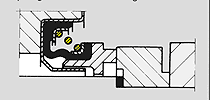 No torque transmission function. Mechanical seal is independent of the direction of rotation. |
 No torque transmission function. Mechanical seal is independent of the direction of rotation. |
|
Characteristics |
Characteristics | Characteristics |
|
|
|